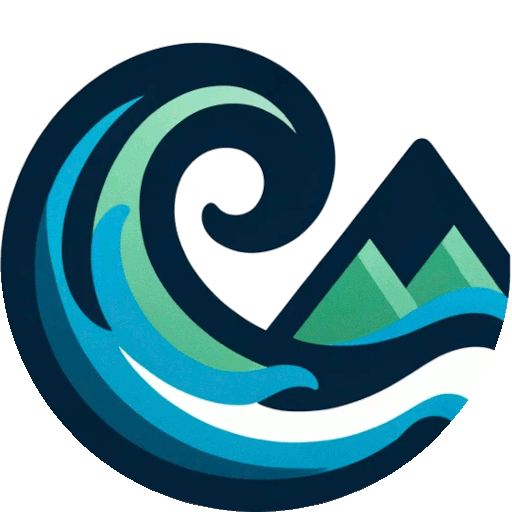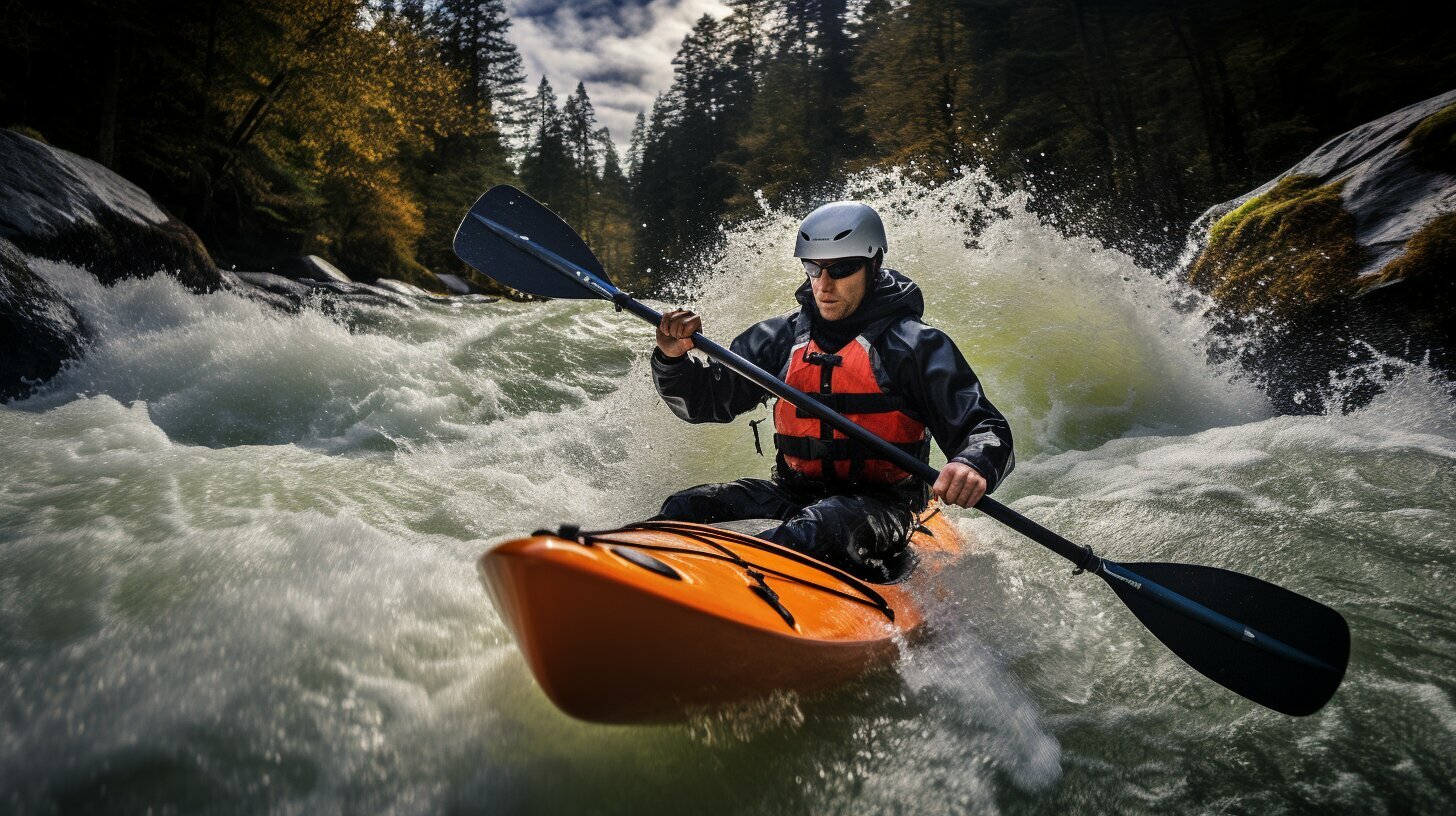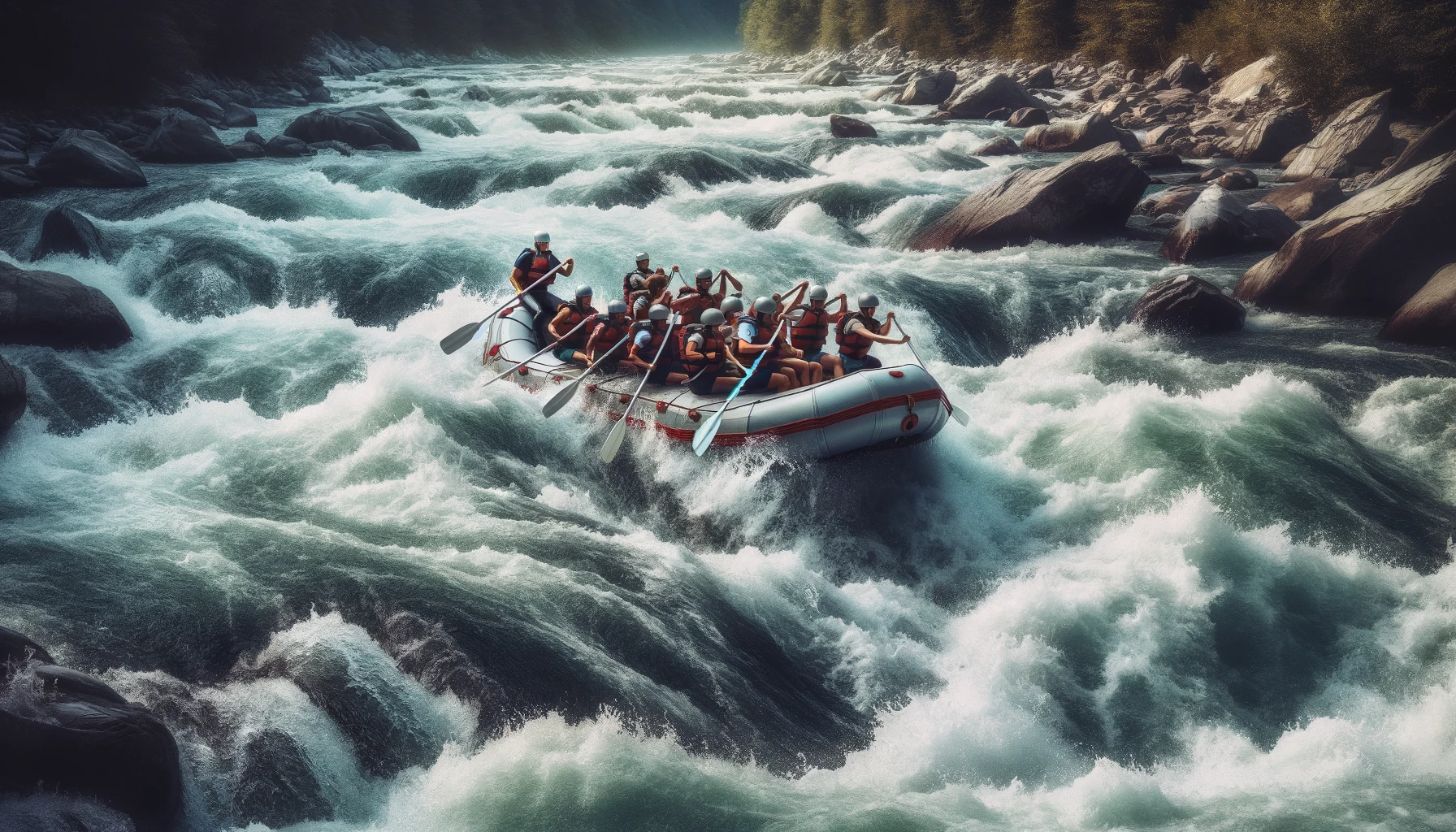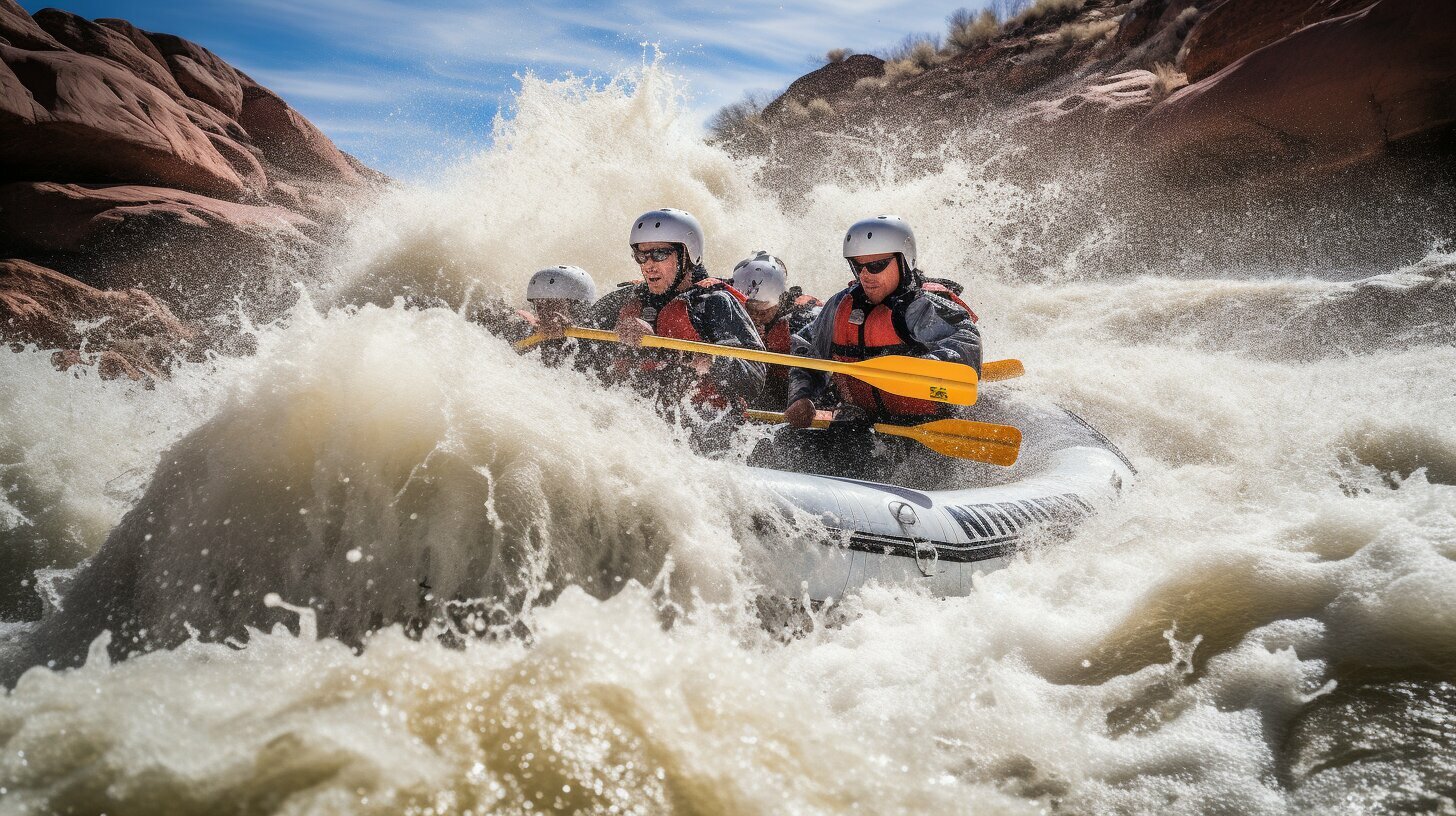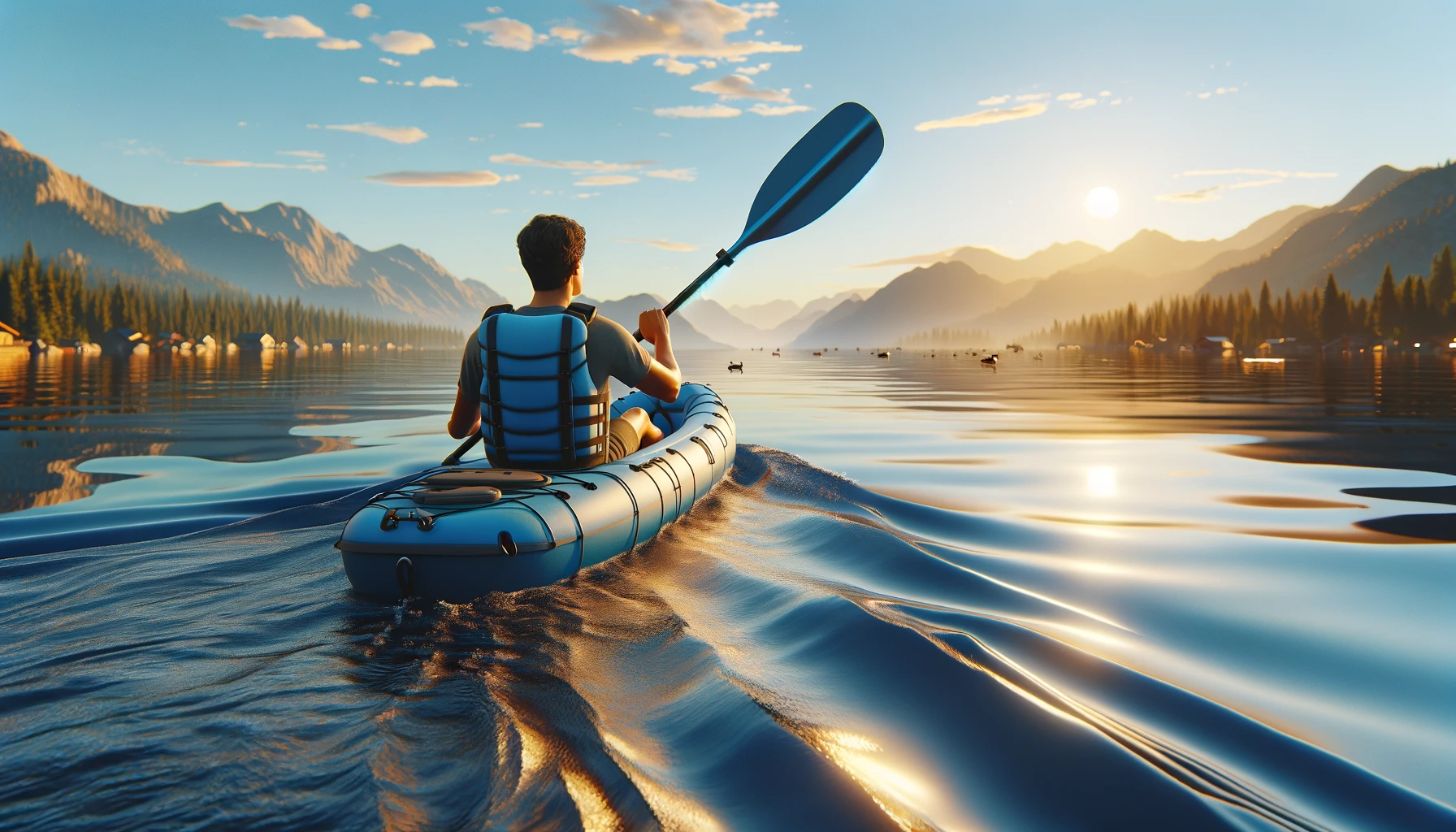If you’re an experienced paddler looking to take your whitewater kayaking skills to the next level, mastering advanced whitewater kayaking techniques is essential. These techniques will enable you to navigate more challenging rapids and take on more exciting river runs.
In this article, we’ll dive into the fundamentals of advanced kayaking techniques, giving you the tools you need to progress as a whitewater kayaker. From mastering advanced paddle strokes to reading and reacting to rapids, we’ll cover everything you need to know to become an expert in advanced whitewater kayaking.
Key Takeaways
- Mastering advanced whitewater kayaking techniques is essential for experienced paddlers looking to progress.
- These techniques will allow you to navigate more challenging rapids and take on more demanding river runs.
- In this article, we’ll cover the fundamentals of advanced kayaking techniques, giving you the tools you need to become an expert.
Understanding the Fundamentals
When it comes to advanced whitewater kayaking, having a strong foundation of basic skills is critical. Before you can tackle more challenging techniques, you need to master the fundamentals of whitewater kayaking.
One of the most important skills to develop in whitewater kayaking is the ability to read and understand the river. Knowing how to identify currents, eddies, and hazards will allow you to plan your route and make quick decisions on the water.
Disclosure: When you buy through links on our site, we may earn an affiliate commission.
Another crucial skill for advanced kayakers is proper paddle technique. From power strokes to draw strokes, having a solid understanding of how to move your kayak efficiently and effectively is essential.
Additionally, learning how to brace and roll your kayak is crucial for staying safe and comfortable in challenging rapids. A strong roll can mean the difference between a minor mishap and a full-blown disaster, so make sure you practice this skill regularly.
Whether you’re a seasoned kayaker looking to up your game or a beginner hoping to build a strong foundation of skills, mastering the fundamentals of whitewater kayaking is the first step to becoming an expert paddler.
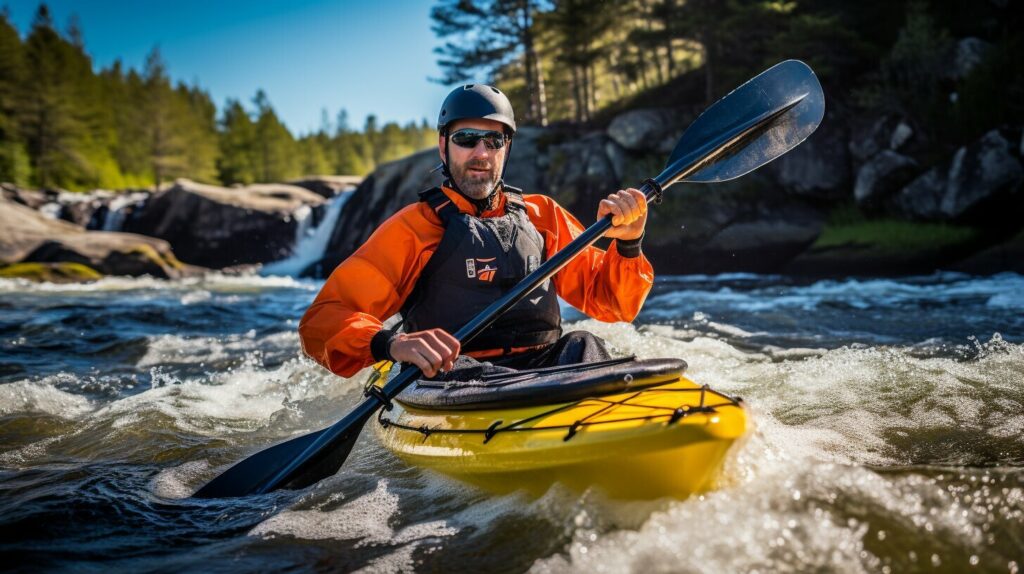
Proper Technique: The Sweep Stroke
The sweep stroke is a versatile kayaking technique that can be used for everything from turning your kayak to keeping it stable in rapids. To execute a sweep stroke, start by placing your paddle blade in the water near your toes, angling it slightly away from the kayak. Keeping your arms straight, pull the paddle blade back towards your hip, sweeping it around the back of the kayak and out to the side.
As you sweep the paddle around, use your hips and torso to steer the kayak in the desired direction. The sweep stroke is a powerful tool, but it can take some practice to master. Start by practicing sweeping on both sides of your kayak, gradually building up speed and power as you become more comfortable with the technique.
Understanding River Currents
To master advanced river kayaking techniques, you need to have a deep understanding of river currents and how they function. River currents are caused by a variety of factors, including changes in elevation, the shape of the riverbed, and the flow of water around obstacles.
As you paddle down the river, you’ll encounter a wide range of different currents, from fast-moving rapids to slow, meandering sections. Understanding how to read whitewater and identify different types of currents will help you anticipate changes in the river and choose the best path forward.
The Power of the Draw Stroke
The draw stroke is an essential kayaking technique that can help you move your kayak sideways or towards you. To execute a draw stroke, start by placing your paddle blade in the water close to your kayak’s side. Keeping your arms straight, pull the paddle blade towards you in a straight line, parallel to the side of your kayak.
The draw stroke can be used to maneuver your kayak in tight spaces, to align yourself with an eddy, or to bring yourself closer to a rock or other obstacle. Practicing your draw stroke and mastering the fundamentals of whitewater kayaking will give you the skills you need to tackle even the most challenging rapids.
Mastering Advanced Paddle Strokes
If you want to take your kayaking skills to the next level, mastering advanced paddle strokes is essential. These techniques will help you navigate challenging rapids with precision, control, and speed. In this section, we’ll cover some of the most important advanced paddle strokes you need to know.
The Sweep Stroke
The sweep stroke is a powerful tool for turning your kayak quickly and efficiently. To execute the sweep stroke, begin by planting your paddle blade in the water at the front of your kayak. Keep your arms straight, and rotate your torso to sweep the blade in an arc behind you, through the water. This will turn your kayak in the opposite direction of the sweep. Use this stroke in combination with other techniques, such as edge control, to make sharp turns and navigate tight channels with ease.
The Draw Stroke
The draw stroke is a handy maneuver that allows you to move your kayak laterally across the current or toward your paddle side. To perform the draw stroke, plant your paddle blade in the water parallel to the side of your kayak, with the blade facing the direction you want to move. Pull the blade back toward your hip, dragging the water alongside the kayak and using it to pull the kayak toward the paddle. This is a great stroke to use when eddying out or maneuvering in tight spaces.
The Brace Stroke
The brace stroke is a technique that helps you maintain balance and prevent capsizing in turbulent water. To execute the brace stroke, lean your kayak toward the side you want to brace, and place your paddle parallel to the water surface on that side. Your lower arm should be fully extended, with the paddle blade just touching the water surface. Push down on the blade with your lower arm to stabilize the kayak. This stroke requires practice and proper timing to perfect, but it can save you from a spill in many situations.
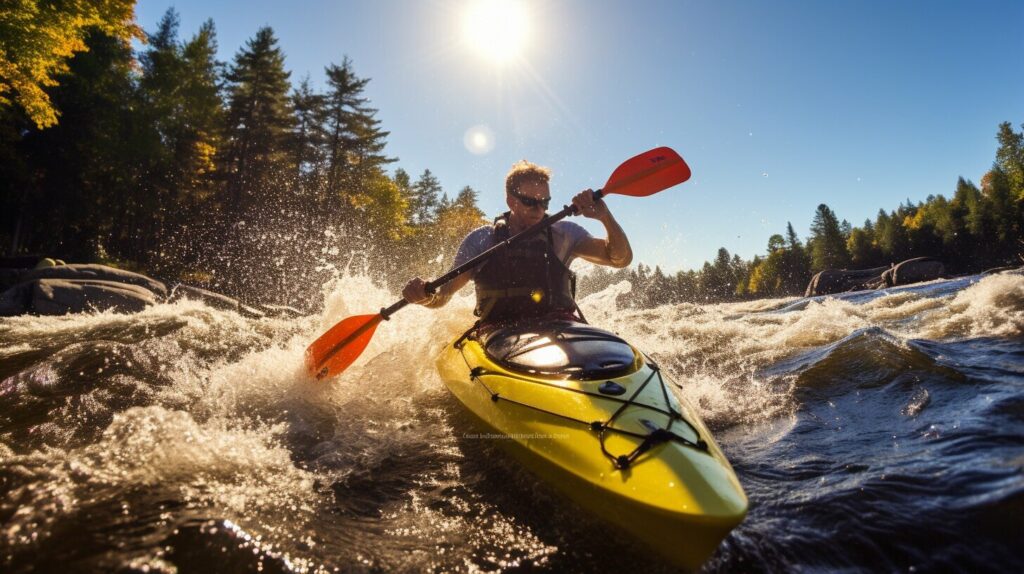
Mastering these advanced paddle strokes takes practice, but with time and patience, you’ll develop the skills you need to tackle even the most challenging whitewater.
Advanced River Maneuvers
As an experienced kayaker, you already possess the fundamental skills to navigate the river. Now it’s time to take it up a notch with advanced river maneuvers. These techniques will allow you to navigate through challenging rapids and overcome obstacles.
Expert tip: Before attempting any of these maneuvers, be sure to first practice them in a safe and controlled environment.
| Maneuver | Description |
|---|---|
| Eddy Turns | Eddy turns are used to change direction quickly by entering and exiting an eddy. This maneuver allows you to position yourself for the next section of rapids. |
| Peel Outs | A peel out allows you to exit an eddy and re-enter the current. This technique is essential for passing obstacles and avoiding hazards. |
| Ferrying | Ferrying is the technique of crossing the current diagonally. This maneuver is commonly used to avoid obstacles or to reach an eddy on the opposite side of the river. |
Mastering these advanced maneuvers requires practice, patience, and persistence. But with proper technique and execution, you’ll be able to navigate through even the most challenging whitewater.
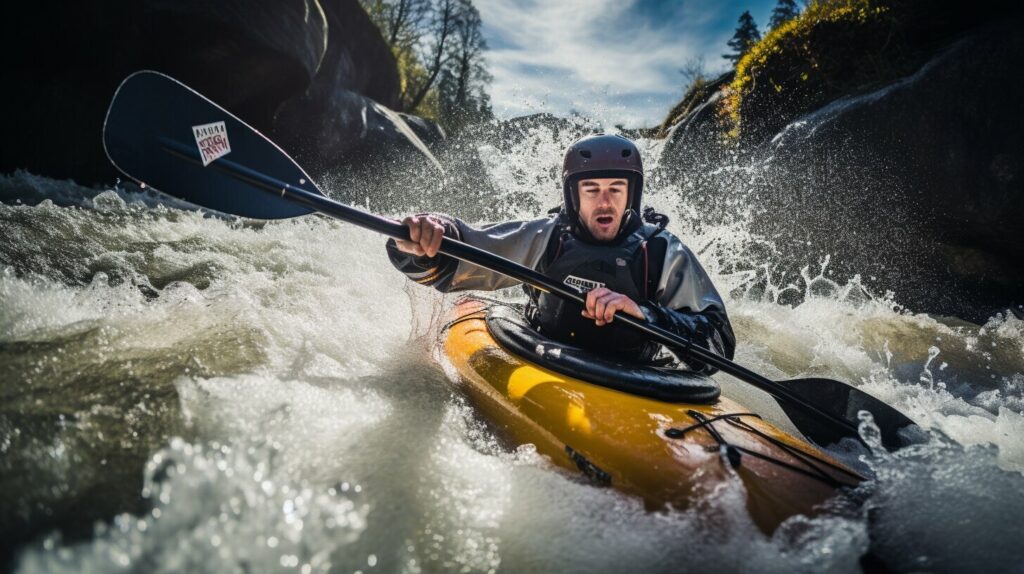
Expert tip: Always be aware of hazards and obstacles on the river, and choose the best line to navigate through them. With practice and experience, you’ll be able to read the water and react quickly to changes in the river.
Reading and Reacting to Rapids
Mastering advanced whitewater kayaking techniques requires more than just physical skill — it requires mental agility as well. Understanding how to read and react to rapids can make all the difference in successfully navigating challenging whitewater.
When approaching a rapid, it’s essential to identify potential hazards and choose the best line to navigate through. Pay attention to the shape and flow of the water, as well as any obstacles such as rocks or logs.
In addition to identifying hazards, it’s important to stay flexible and adaptable on the river. Unexpected changes can occur quickly, so always be prepared to make split-second decisions and adjust your course accordingly.
Mastering whitewater kayaking also requires a deep understanding of river currents. Understanding how water moves through rapids can help you identify safe routes and avoid hazards.
To improve your skills in reading and reacting to rapids, it’s important to practice on a range of rivers and in different conditions. By seeking out new challenges and practicing your skills, you’ll be better equipped to handle any rapids that come your way.
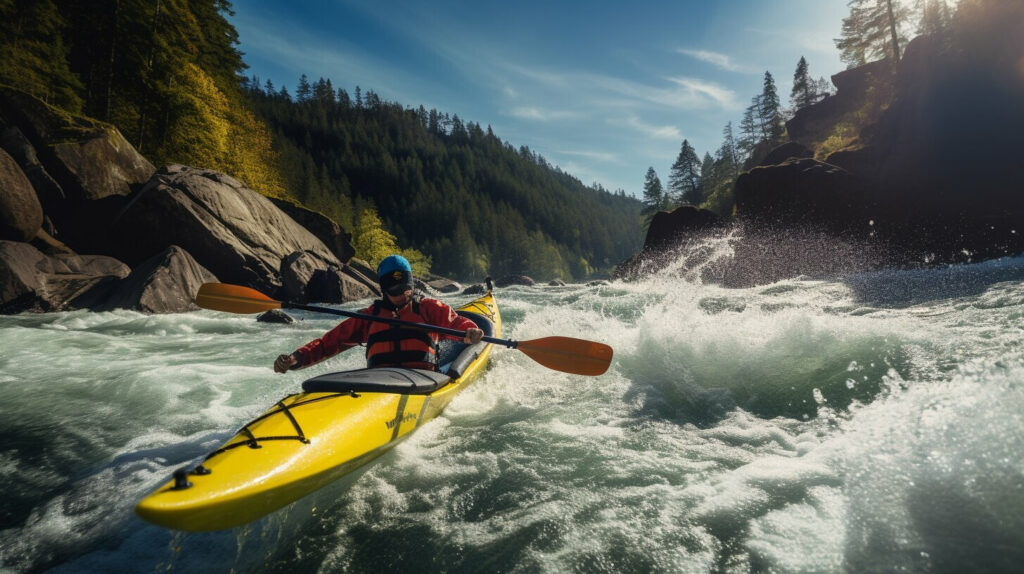
Image alt text: mastering whitewater kayaking
Techniques for Rolling in Whitewater
If you’re an experienced kayaker, you know that rolling your kayak is an essential skill that can save your life if you capsize in whitewater. However, in advanced kayaking, rolling requires much more than just the basic technique. To master rolling in whitewater, you need to prepare your body and mind, so you react quickly and calmly in unexpected situations.
Before practicing advanced rolling techniques in whitewater, make sure you have a solid roll in calm water. Practice rolling on both sides, so you can react quickly in any situation. Once you’re confident with your basic roll, you can start expanding your skills.
One important technique is the C-to-C roll, which is a quick roll that allows you to recover from a capsized kayak while maintaining your momentum. To do this roll, first, set up with your body facing the bottom of the river. Then, initiate the hip snap and sweep your paddle from one end of your kayak to the other before pulling it towards your hip to complete the roll.
Another important technique for advanced kayakers is the back deck roll, which allows you to initiate a roll from the back deck of your kayak. This technique is useful when you need to roll quickly in turbulent water. To perform this roll, tilt your head back and reach behind your head with your paddle, keeping your body low and close to the kayak.
Finally, to prepare your body for the physical demands of advanced rolling techniques, you need to build strength and endurance. Incorporate core and upper body exercises into your training routine, such as planks, pull-ups, and push-ups.

Remember, rolling in whitewater requires practice and patience. Take your time and focus on mastering each technique before moving on to the next. With enough practice, you’ll be able to roll confidently in even the most challenging rapids.
Advanced Safety Measures
When it comes to advanced whitewater kayaking techniques, safety should always be your top priority. As an experienced paddler, you know that the risks are higher on more challenging waters, and you need to be prepared for any situation that may arise. Here are some advanced safety measures to keep in mind:
- Choose the right gear: Make sure you have the appropriate safety gear for the conditions you will be facing, including a proper fitting personal flotation device (PFD), helmet, wetsuit, and drysuit.
- Practice rescue techniques: Be prepared to help others in your group with rescue skills such as T-rescues, Eskimo rolls, and throw bagging.
- Communicate effectively: Clear communication is essential on the river. Before you start your trip, make sure everyone is aware of the plan, the roles they will play, and what to do in case of an emergency.
Keep in mind that this is not an exhaustive list, but rather a starting point for advanced safety measures. There are many more skills and techniques you can learn to stay safe on the water. Don’t hesitate to seek out additional training or resources to expand your knowledge and experience.
Remember, taking the necessary safety precautions will not only help you avoid injury, but also keep you relaxed and confident, making for a more enjoyable paddling experience.
Expanding Your Whitewater Skills
Now that you’ve mastered advanced kayaking techniques, it’s time to expand your skills and continue pushing your limits. Here are some tips for taking your whitewater kayaking experience to the next level:
- Seek out new challenges: Don’t be afraid to venture into new waters. Seek out new rivers with different challenges and difficulty levels to continue improving your skills.
- Join kayaking communities: Joining a local kayaking club or online community can provide a wealth of knowledge and resources. You’ll have access to experienced kayakers who can offer guidance and advice.
- Attend advanced training programs: Advanced training programs, such as whitewater kayaking clinics and courses, can help you develop more expert kayak techniques and expand your knowledge of the sport.
Remember, always prioritize safety and continue practicing and refining your skills. With dedication and perseverance, you’ll be able to take on even the most challenging rapids and elevate your whitewater kayaking experience to new heights.
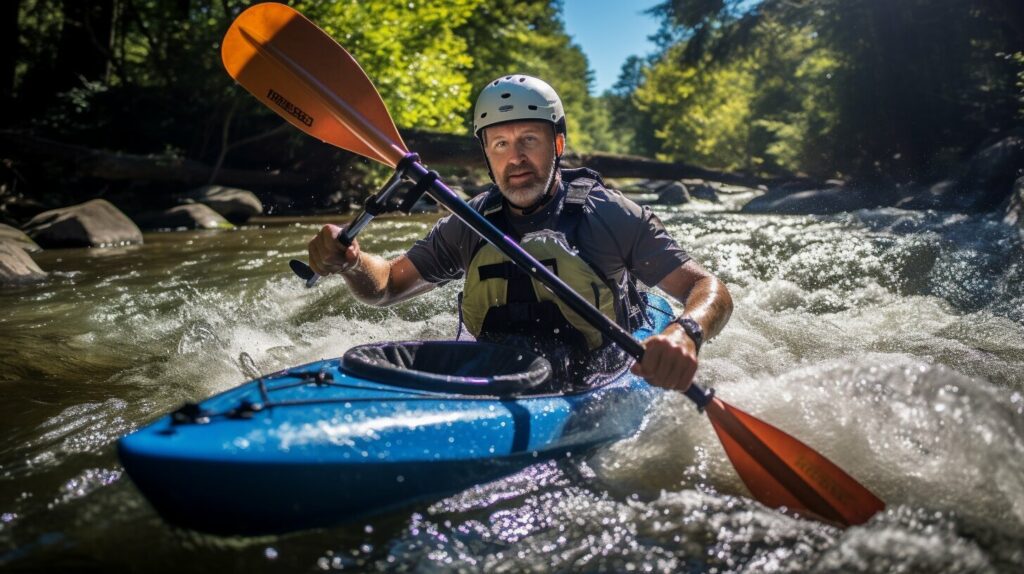
Whitewater Kayaking Etiquette
As an experienced paddler, you know that the whitewater kayaking community is a close-knit group that values respect and safety on the river. Following proper etiquette is not just a matter of courtesy, but also crucial for everyone’s safety. Here are some advanced kayaking techniques for experienced paddlers to follow:
- Right-of-way rules: When encountering others on the river, it’s important to understand who has the right of way. Generally, downstream traffic has the right of way, meaning that upstream kayakers should yield to those coming downstream.
- Communication on the river: Proper communication with your fellow paddlers can prevent accidents. Use hand signals, calls, or other means to communicate throughout the journey. Learn and use the International Scale of River Difficulty to communicate the level of difficulty of the rapids.
- Leave No Trace principles: Tread lightly on the environment and minimize your impact on the river. Carry out what you carry in, including all trash and waste.
Remember that your actions on the river can also affect others around you. Be aware of your surroundings and how your paddling may impact others. Show respect for fellow paddlers, wildlife, and the environment, and you’ll earn the respect of the entire whitewater kayaking community.
Keep these advanced kayaking techniques for experienced paddlers in mind as you navigate the river, and you’ll help maintain a safe and enjoyable experience for everyone.
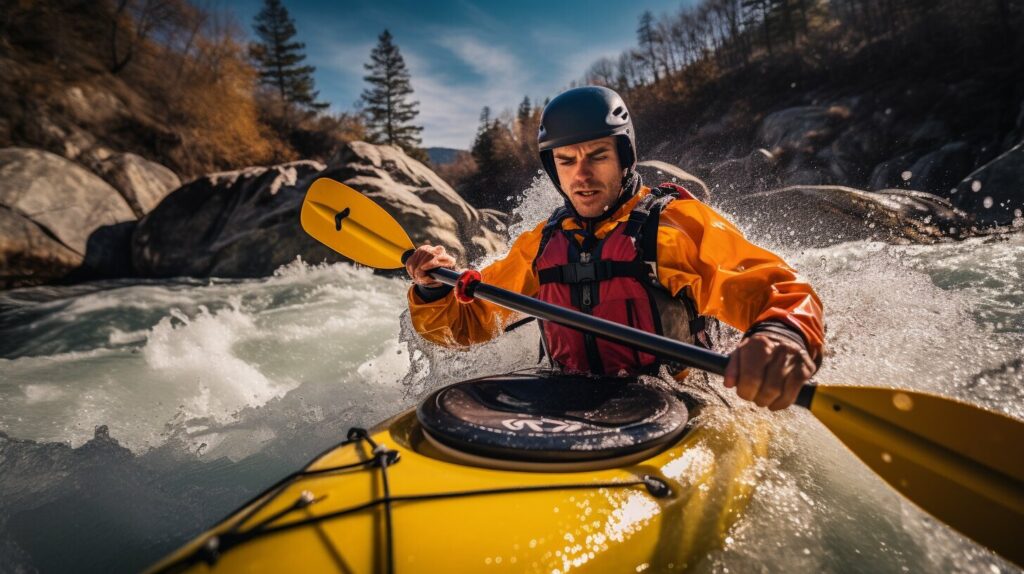
Staying Mentally and Physically Prepared
Advanced whitewater kayaking requires not only technical skill but also mental and physical preparation. To ensure you can handle the demands of advanced kayaking, it’s crucial to focus on your fitness, mental resilience, and stress management.
Physical preparation is a must for advanced kayaking. You need to exercise regularly to build strength, endurance, and flexibility. Cardiovascular training is also essential to build your lung capacity and improve your stamina. Additionally, stretching and yoga can help keep you supple, reducing the risk of cramps and injury.
Mental preparation is equally important. Advanced kayaking calls for quick thinking, sound judgment, and the ability to stay calm under pressure. To improve your mental resilience, incorporate mindfulness and deep breathing exercises into your routine. Practice staying focused, and develop strategies to manage anxiety and fear.
It’s also essential to stay well-rested and well-fed. Lack of sleep, dehydration, and poor nutrition can all affect your performance, leading to mistakes and accidents. Make sure you’re getting enough sleep, drinking plenty of water, and eating a balanced diet rich in whole grains, fruits, vegetables, and lean proteins.
Remember, advanced kayaking is a team sport, and it’s essential to support your fellow paddlers. Being mentally and physically prepared not only helps you stay safe but also ensures you can contribute to the group’s success and overall enjoyment of the experience.
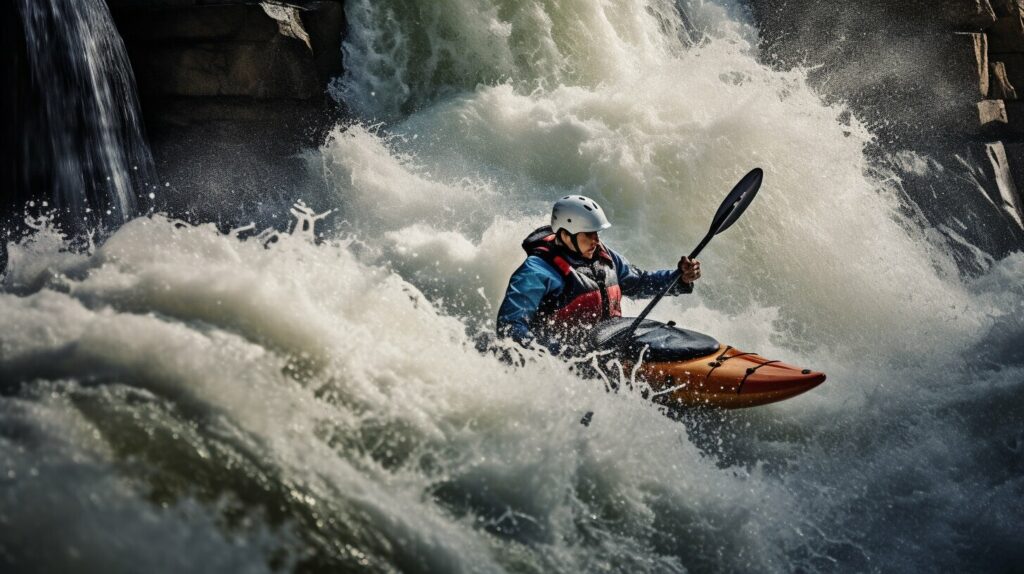
Elevate Your Whitewater Kayaking Experience
By mastering advanced whitewater kayaking techniques, you’ve taken your kayaking to the next level. You’re now among the elite group of experienced paddlers who can navigate challenging rapids with ease and confidence. But don’t stop there – the journey to becoming an expert kayaker never truly ends. Here are some tips for elevating your whitewater kayaking experience even further:
Push Your Limits with New Tricks
Now that you’ve mastered the fundamentals, it’s time to start experimenting with new tricks and maneuvers. Try out advanced techniques like the stern squirt, wave wheel, or air screw to impress your fellow paddlers and enhance your skills. Keep in mind that mastering new tricks takes time and patience, so don’t get discouraged if it doesn’t come easily at first.
Challenge Yourself with Tougher Rapids
As you become more confident on the river, it’s natural to seek out more challenging rapids to test your skills. But don’t bite off more than you can chew – always assess the difficulty of a rapid before running it, and never attempt something that’s beyond your abilities. Consider joining a paddling club or signing up for guided trips to discover new stretches of whitewater that will push you to your limits.
Stay Safe and Respectful
As an advanced kayaker, it’s your responsibility to set an example for others on the river. Practice good safety habits like wearing proper gear, scouting rapids before running them, and knowing how to perform rescues if necessary. And always show respect for other paddlers, following right-of-way rules, communicating clearly on the river, and practicing leave no trace principles.
Continue Learning and Improving
Even the best kayakers know that there’s always room for improvement. Seek out opportunities to expand your skills, whether it’s by attending advanced training programs, watching online tutorials, or joining a community of experienced paddlers. The more you learn and practice, the better you’ll become – and the more thrilling your whitewater kayaking experiences will be.
By following these tips, you can continue to elevate your whitewater kayaking experience and enjoy all the thrills and excitement that this challenging sport has to offer. So get out on the river, push your limits, and keep mastering those advanced techniques and whitewater kayaking tricks!
FAQ
Q: What skills are considered advanced whitewater kayaking techniques?
A: Advanced whitewater kayaking techniques include mastering advanced paddle strokes, advanced river maneuvers, reading and reacting to rapids, rolling in whitewater, advanced safety measures, expanding your whitewater skills, whitewater kayaking etiquette, and staying mentally and physically prepared.
Q: How can I improve my advanced paddle strokes?
A: To improve your advanced paddle strokes, practice techniques such as the sweep stroke, draw stroke, and brace stroke. Focus on proper form, body positioning, and timing. It can also be helpful to seek guidance from experienced kayakers or attend advanced training programs.
Q: What are some common advanced river maneuvers?
A: Common advanced river maneuvers include eddy turns, peel outs, and ferrying. These techniques allow kayakers to navigate difficult sections of whitewater and maintain control in challenging river conditions.
Q: How important is reading and reacting to rapids?
A: Reading and reacting to rapids is crucial for advanced whitewater kayaking. By understanding the flow of the river, identifying hazards, and choosing the best lines, kayakers can make split-second decisions to navigate safely through rapids.
Q: What are some techniques for rolling in whitewater?
A: Techniques for rolling in whitewater include different rolling techniques, maintaining a solid roll in turbulent water, and performing exercises to improve roll recovery. It is recommended to practice rolling in controlled environments before attempting it in whitewater.
Q: How can I ensure safety while practicing advanced whitewater kayaking?
A: Ensuring safety while practicing advanced whitewater kayaking involves proper gear selection, learning rescue techniques, and effective communication on the river. Always paddle with a group or let someone know your plans, and be prepared for unexpected situations.
Q: How can I expand my whitewater kayaking skills beyond the advanced level?
A: To expand your whitewater kayaking skills beyond the advanced level, seek out new challenges, join kayaking communities, and attend advanced training programs. Pushing your limits and continuously learning will help you grow as a kayaker.
Q: What is whitewater kayaking etiquette?
A: Whitewater kayaking etiquette involves respecting other paddlers and the environment. Follow right-of-way rules, communicate effectively on the river, and practice leave no trace principles to minimize your impact and maintain a positive paddling experience for everyone.
Q: How important is mental and physical preparation for advanced whitewater kayaking?
A: Mental and physical preparation is crucial for advanced whitewater kayaking. Maintain good physical condition through regular exercise and training, manage fear and stress on the river, and stay mentally focused to make quick decisions in challenging situations.
Q: How can I elevate my whitewater kayaking experience?
A: To elevate your whitewater kayaking experience, apply the advanced techniques you have learned, continue pushing your limits, and seek out new opportunities for growth. Mastering advanced whitewater kayaking techniques will enhance your skills and enjoyment on the river.
